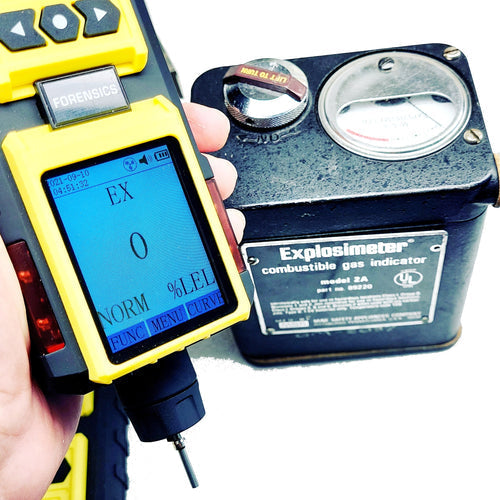An explosimeter, also known as a flammability tester, is a gas detection device used to monitor the presence of combustible, flammable gases and volatile vapors in various industries. This electronic gas meter accurately measures the concentration of these dangerous substances between 0 and 100% of the lower explosive limit (LEL), providing crucial information about the potential risk of explosions or fires. Explosimeters are widely used in the oil and gas, petrochemical, refining, R&D, and industrial processing sectors to assess the volatility and flammability of gases and vapors, offering a reliable indication of their vapor pressure on a relative basis. By utilizing these instruments, professionals in these industries can ensure the safety of their work environments, prevent accidents, and protect both personnel and equipment from the devastating consequences of undetected flammable gas accumulation.
Pros |
Cons |
|
✅ Explosimeters are useful tools for fast volatile gas or vapor analysis. ✅ The MSA Explosimeter series has served the industry well since 1940. ✅ New version of the explosimeter have been innovated with all inclusive micro-pump (no need for the traditional hand pump, aspirator). |
⛔ Explosimeters and combustible gas detectors do not discriminate between the hundreds of different volatile gases and vapors. ⛔ These units typically employ catalytic pellistor type sensors and require at least 10% of oxygen for reliable measurement. ⛔ Explosimeters require calibration between 6 to 12 months and last from 2 to 4 years. |
The Best Explosimeter?
The original explosimeter was invented in 1940 by MSA which has been recently discontinued. The "explosimeter" trademark is now owned by Forensics Detectors. The reputable brands of combustible and explosimeter gas detectors include the following:
- Forensics Detectors Explosimeter
- MSA Explosimeter (Discontinued)
- Klein Tools Combustible Gas Leak Detector
- UEI Gas Leak Detector
- Ridgid Combustible Gas Leak Detector
- Inficon Gas Leak Detector
- Sensit Leak Detector
- Extech Gas Leak Combustible Detector

What Is a Explosimeter?
A explosimeter is an electronic gas meter that detects combustibles, flammable gases and volatile vapors. These instruments are used to assess gases and vapor for volatility, flammability and provides a good indication of the vapor pressure on a relative basis. These units are commonly used in the oil and gas industry, petrochemical industry, refining industry, R&D and industrial processing. An Explosimeter is also called a combustible gas detector, flammable gas detector, combustible gas detector, gas leak detector or flammable gas analyzer.
What is the difference between an Explosimeter and a Combustible Gas Detector?
There is no difference.
Traditionally, the word explosimeter was coined and trademarked by MSA in 1940. Over the many decades of its use, it has become a synonym for a Combustible Gas Detector. Flammable Gas Analyzer is also used to describe a Explosimeter or Combustible Gas Detector.
What Does an Explosimeter Detect?
An explosimeter detects combustible gases and vapors in air. In other words, it detects the presence of flammable gases and vapors. In doing so, it provides a indication if the atmosphere is dangerous.
If the combustible gas or vapor is a high boiling point solvent, a relatively low vapor concentration will be detected. If the temperature increase, the combustible will be more volatile, and hence, the vapor concentration will increase, hence increase the explosimeter %LEL reading.
Does it detect Explosive Dusts?
No it does not.
An explosimeter does not detect the explosivity of combustible mists or sprays. It does not detector explosive dusts such as grain or coal dust.
What is the difference between an Explosimeter and a Tankscope?
A Tankscope is very similar to a Explosimeter in that both detect combustible gases and vapors.
Traditionally, the Tankscope was designed by MSA to detect combustibles in an inert environment - which means an environment deprived of oxygen.
A typical combustible gas detector (and explosimeter) requires at least 10% of oxygen to correctly operate. However, due to the operate and sensor selection of the Tankscope, it can detector combustibles in an inert environment, such as a large tank or silo.
In addition, the Tankscope reading is an absolute reading, showing %volume. The explosimeter presents to the user, the detected concentration as a %LEL reading.
What Are Explosimeters Used for?
Gas and Vapor Sample AnalysisThis units are used to determine the volatility of a sample liquid. This is typically used in the oil and gas industry and in R&D. This serves as a fast qualitative measure of a "relative" volatility. The EX LEL% can be calibrated to known liquid vapor pressures, however, the size of the sample vial, temperature, liquid volume and agitation are all key factors to consider.
|
Personal ProtectionThe majority of combustible gas detectors are used for personal protection and commonly used in confined spaces to ensure safety. These units are small and portable, battery-powered units.  |
Gooseneck Combustible Gas Leak DetectorsGas Leak detectors are also combustible gas detectors. However, the difference is (a) typically gas leak detectors present the user with a ppm combustible value (calibrated to methane). So, it is a much more sensitive measurement compared to a %LEL. In addition, these unit employ FIGARO type semiconducting oxide sensors.
|
Fixed Wall Combustible MonitorsWall-mounted units provide continuous protection and alarm if a dangerous flammable environment exists. These units are important for storage facilities, work facilities, process and manufacturing areas.  |
How do Volatile Liquids Create An Explosive Environment?
Combustible and flammable liquids may off-gas or vaporize that will then produce a flammable environment. These liquids may be petrochemical products such as diesel, gasoline, isopropanol and many other hydrocarbon flammable liquids.
Molecules will off-gas when they have enough energy (thermal) to overcome the intermolecular forces holding them in the liquid or solid phase. Indeed, variables such as agitation and temperature add to the energy component that may further enhance off-gassing or vaporization. In doing so, these gas molecules produce a pressure on the liquid or solid (within a sealed container). This is known as the vapor pressure. So in other words, the higher the vapor pressure, the more off-gas or vapor exists in the atmosphere. Liquids with higher vapor pressures have a lower flash point and are therefore more flammable.
Interestingly, this phenomena occurs all around us. Think of when you are filling up your car at the gas station. One can often smell the gasoline vapors. The molecules originate in the liquid state. Then, enter the gas phase and are then detected by ones nose. If enough gasoline molecules accumulate within a volume of space, it may be enough to create a flammable environment, and hence the important of the EX LEL scale (see below).

How Does an Explosimeter Work?
An explosimeter or combustible gas detector is composed of electronics and combustible catalytic bead sensor. The gas sensor converts the detected gas concentration to an electronic signal. This electronic signal is processed and compared to a calibration graph (gradient) which then finally displays the corresponding EX LEL% concentration reading.
The most important component of the meter is the sensor.
Explosimeters and combustible gas and vapor detectors employ a catalytic bead sensor, often referred to as a pellistor sensor or filament. This element detects combustibles by oxidizing or “burning” the combustible gas on an active bead. The heating effect changes the sensor's conductivity, which is proportional to the amount of combustible gas detected. Integrated with a heating element to operate at about 500F, this device is often very small. The sensor contains two beads, one active and one not. It is typically placed in a Wheatstone bridge configuration.

Combustibles Sensor Technology |
Working Principle |
Pros |
Cons |
| Catalytic Bead Pellister Sensor | Combustible gas oxidizes on the bead, changing the conductivity of the element. The resistance change is proportional to the combustible concentration. |
|
|
How Long Does a Flammable Gas Detector last for?
Combustible Gas Detectors employ catalytic bead pellistor type sensors that last up from 2 to 4 years.
How Do I Test My Explosimeter?
The best way to test your Combustible Gas Detector is via a Bump test. Bump testing is good practice to perform daily. This task exposes the detector to some combustible gas such as methane. Frequent testing is especially important in personal protection applications where safety is paramount.
How do I Calibrate a Flammable Tester?
All explosimeters, combustible gas detectors and similar, all require periodic calibration. Calibration is required to ensure accurate gas readings. Over time, the sensors on the device will degrade or produce drifting readings. We suggest calibrating your detector every 6 to 12 months. See more info here on calibration.
Be attentive and calibrate more often (daily) if:
- The unit is being used as an analytical tool where accuracy is paramount.
- The instrument is in extreme environment (temp and humidity extremes create sensor drift).
- The user is performing an imminently dangerous application. Sampling a tank or silo situation, bump and calibration before use.
- Bump testing fails.
- The meter is alarming erratically in the fresh air. This could mean that the sensor has drifted past an alarm set-point.
Also here are some precautionary items also:
- Calibration and bump testing are mandatory because injury or death can occur if the device fails.
- Have a calibration schedule. Ensure correct training. See gas calibration here.
Can You Smell Combustible Gases And Vapors?
Yes, many combustible gases have distinctive odors. Natural gas has an added rotten-egg smell, while gasoline has a strong chemical odor for safety detection.
Final Words
An Explosimeter, also dubbed a combustible gas detector, flammable tester, or gas leak detector, plays a vital role in identifying combustible gases, flammable gases, and volatile vapors. Crucial across industries like oil and gas, petrochemicals, and industrial processing, it ensures personnel and equipment safety by spotting potentially hazardous gas build-ups. The renowned MSA Explosimeter series, a trusted choice since 1940, has introduced an innovative version. Featuring an all-in-one micro-pump, it eliminates the need for traditional hand pumps and comes at an affordable price below $400. This advancement enhances usability, offering reliable gas detection solutions and fostering a safer working environment industry-wide.
About The AuthorDr. Kos Galatsis ("Dr.Koz") is the President of FORENSICS DETECTORS, where the company operates from the scenic Palos Verdes Peninsula in Los Angeles, California. He is a subject matter expert on gas sensor technology, gas detectors, gas meters, and gas analyzers. He has been designing, building, manufacturing, and testing toxic gas detection systems for over 20 years. 
Every day is a blessing for Dr. Koz. He loves to help customers solve their unique problems. Dr. Koz also loves spending time with his wife and his three children going to the beach, grilling burgers, and enjoying the outdoors. Read more about Forensics Detectors here. Email: drkoz@forensicsdetectors.com
|




